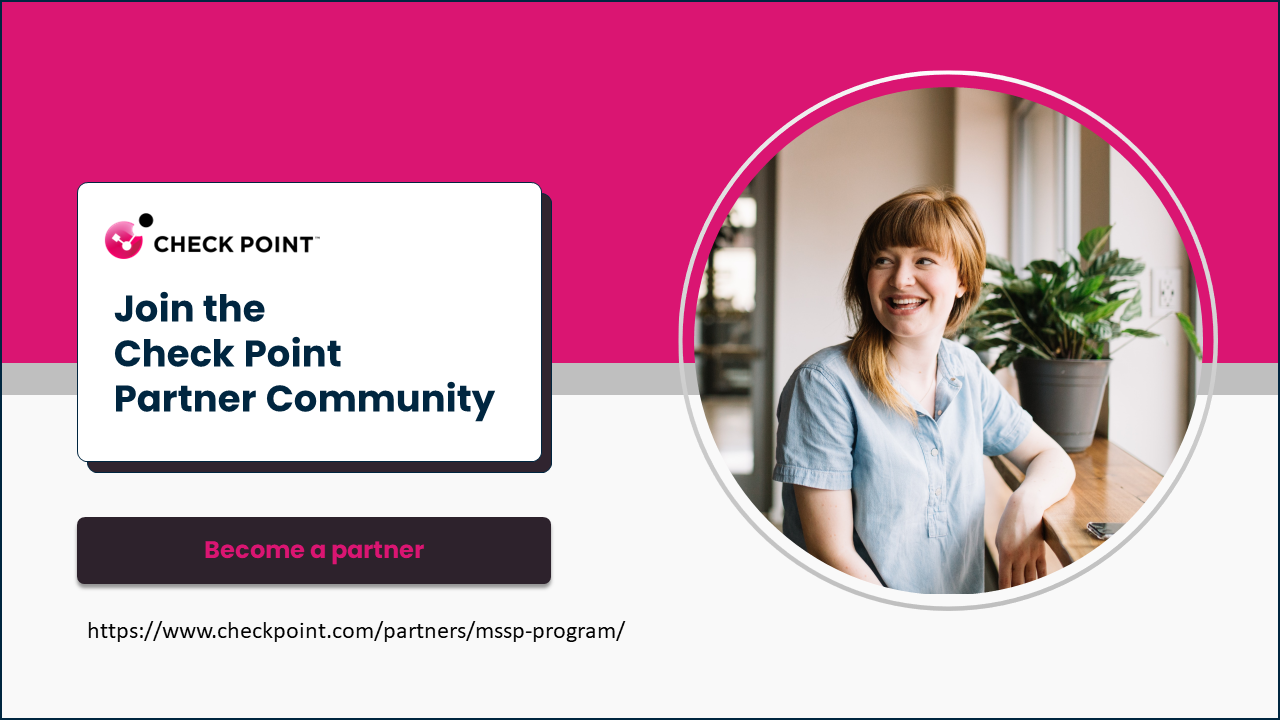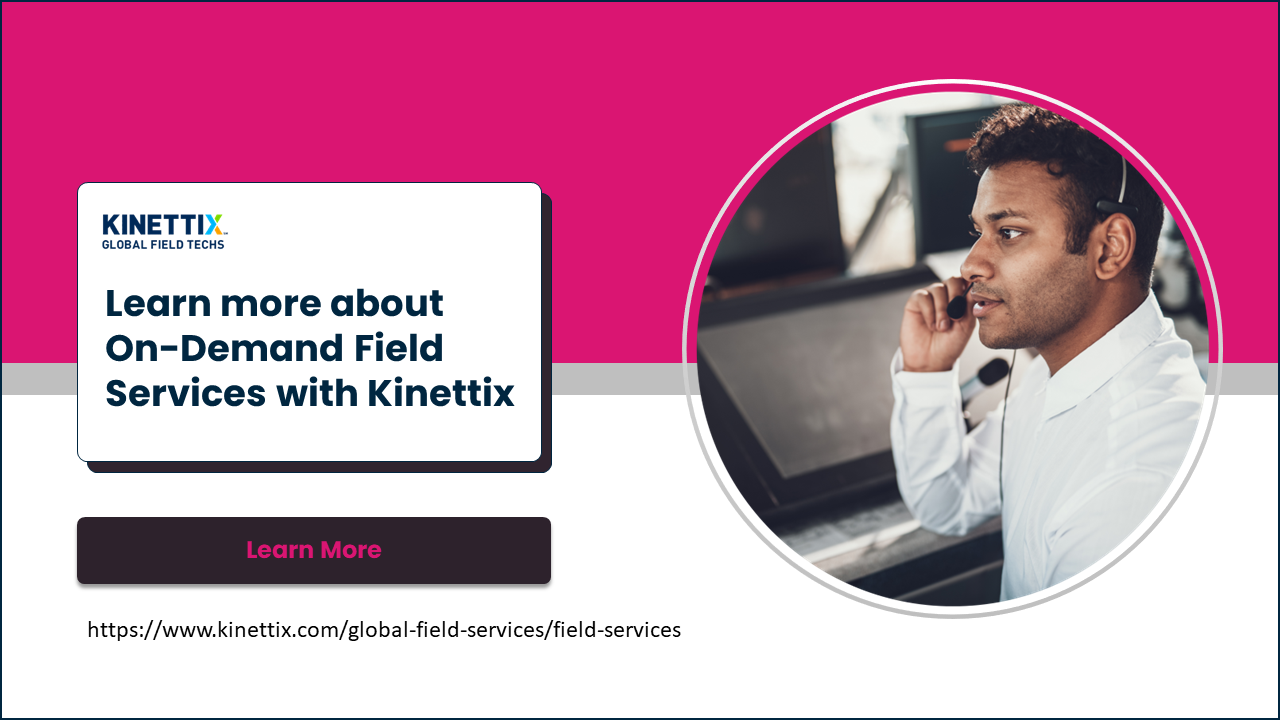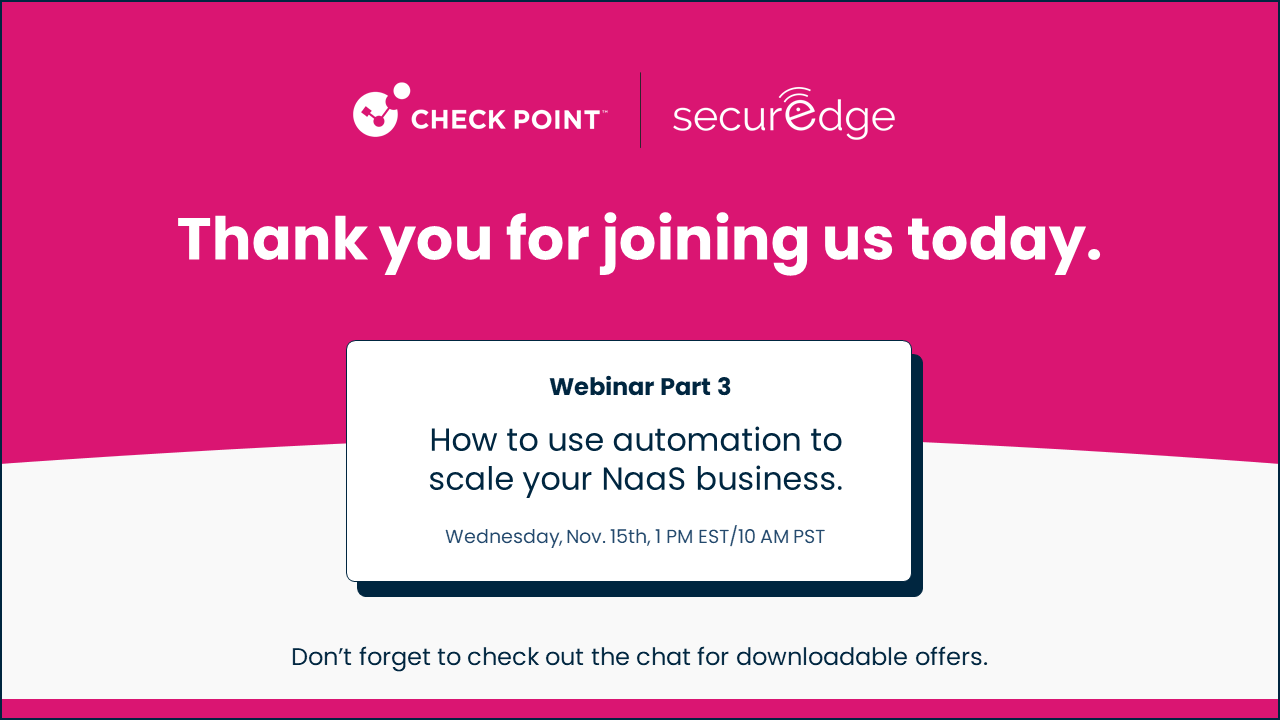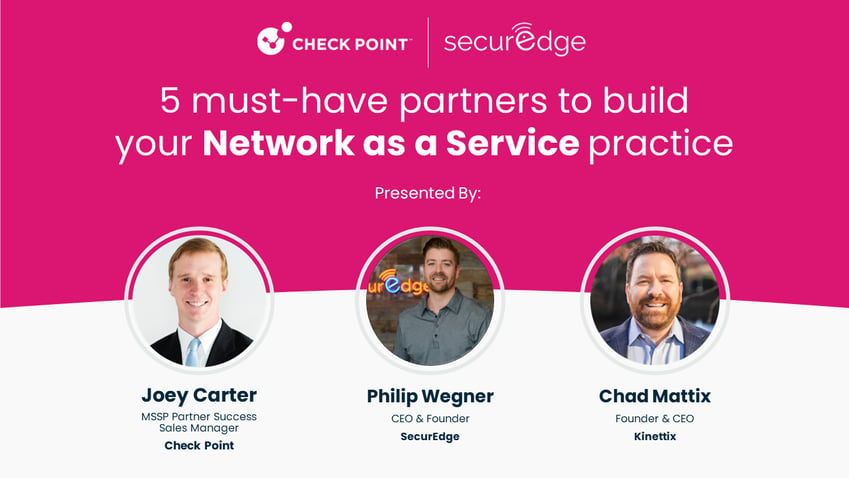
Introductions
Okay. So, I guess, we're gonna get started here. So, I'm Philip and I'm with SecurEdge.
We have another webinar in this series that we started talking about last month, which was really all about how to build and scale a network as a service practice.
Now in this session, I brought a bunch of people. We actually thought about having four or five people, but it ended up being too much.
But today I've got Joey Carter (MSSP Partner Success Sales Manager, Check Point), and I've got Chad Mattix (Founder & CEO, Kinettix).
So, Joey, if you could introduce yourself, who you're with, and what you do, and then Chad, if you could do that after that.
Yeah. Thanks, Phil. Appreciate the opportunity to be here.
Joey Carter with Check Point and my role at Check Point is I work with service providers all over the United States. So my title is MSSP partner success sales manager.
So really working on a day-to-day basis with service providers. And, yeah, excited to be here.
Okay, Chad. Talk a little bit about your background. I’ve looked at your LinkedIn profile. You've got quite an extensive background. So feel free to go as far back as you want.
Well, thank you for the opportunity to be here. Yeah. Chad Maddox with Kinettix.
Our company was founded in 2016. We are functionally focused on field service. We support large IT and mid-sized service providers. It's the “hands and feet” or putting technology on-site.
Been doing this for a long time, which may be implied by the length of my LinkedIn profile there. But, as an organization, we are scaling the ability to get techs on-site to complete a variety of different types of tasks. I've been doing this for a long time, on a global footprint, and have also been involved in a variety of different types of startups around the field service or The Edge device, support.
We are based in Cincinnati, Ohio. We've tried to incubate a couple of different businesses from here around this over the last six years now, it's been a growth for us in terms of our marketplace and how we're working with SecurEdge to scale.
So, very interested in how we drive with APIs and different types of connections into the field services, deploying the infrastructure as it has been a pretty traditional spreadsheet list of tech-driven type of models and we're trying to transform how that's done today.
I’m Philip. I’m the CEO of SecurEdge and I started SecurEdge back in 2006 as a VAR and managed service provider.
Several years ago, we sold the services side of the company because we've been building software. The software that we were working on was to do a lot of things that we're talking about today.
I think it's where people talk about digital transformation and all these types of terms or whatever and they're really overused. But it is funny that, in our industry, we're selling networking and data and all that and then when you go inside of a lot of VARS or MSPs and you ask them about internal processes, they're like, well, it starts in an email or it starts in a spreadsheet.
We're like, are we talking about digital connectivity and transformation for the customers? It's just really funny. So, I'm with you on making it all work together as one.
That's really what we're gonna talk about today. In the first session, we talked about why you wanna build a Network as a Service practice. We really got into the numbers because it's actually a very profitable business and that was the first session that we had last time.
What is a Solution Partner?
Today, we're gonna talk about the concept of how you can deploy or build your business utilizing partners.
Now, partners in some instances or some circles is considered kind of a dirty word if you will. Sometimes you'll go into a company that's an MSP or VAR and you say, “Hey, do you guys work with partners?” and they are, like, “Well, no, we don't do that”.
I wanted to define what a partner is and then what that actually means. So, we just define a partner as a solution partner and that’s a longer way to say it.
But it's really any partner that you work with that helps you support your customers. That could be lots of different companies. Could be manufacturers, distributors, or field services companies like Chad's company.
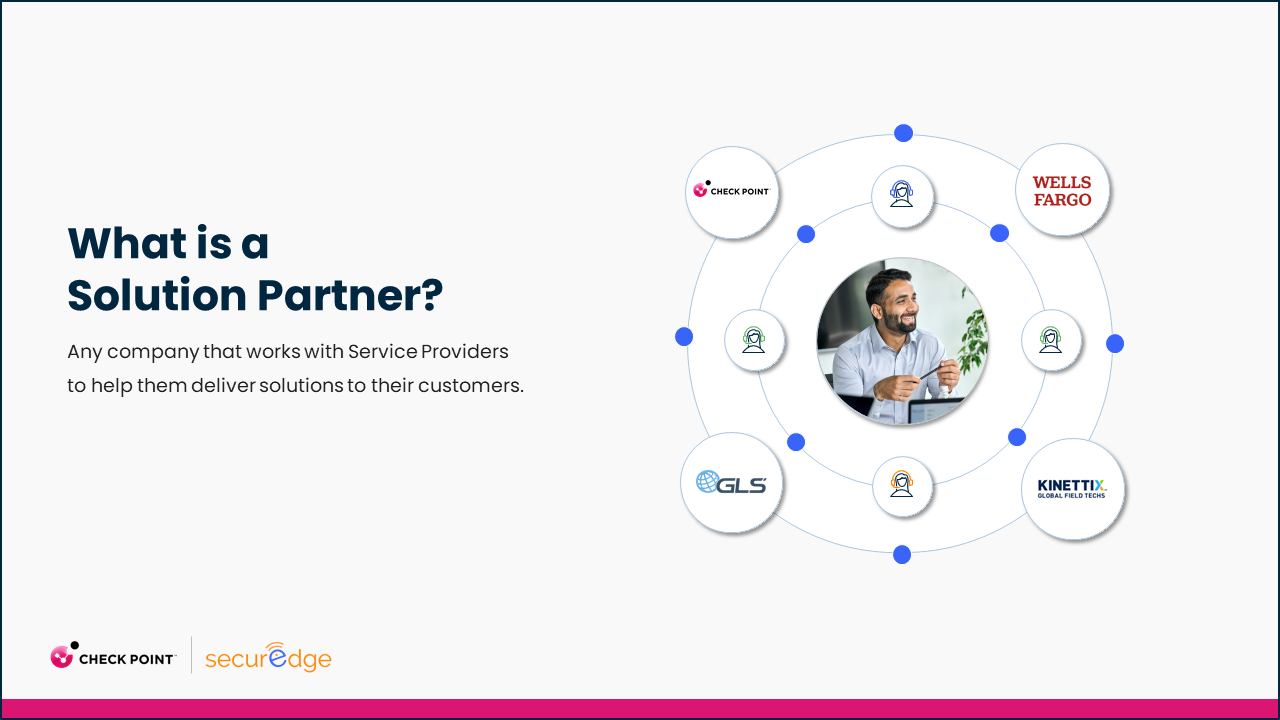
So, we're gonna unpack a little bit about that.
The first thing I wanna do is establish is, what is an actual solution partner, if you're a VAR or MSP, watching this webinar.
The second thing that I really just wanted to talk about before we get started is something that a lot of people maybe don't spend a lot of time thinking about and that is thinking about partnerships as a strategic advantage in business.
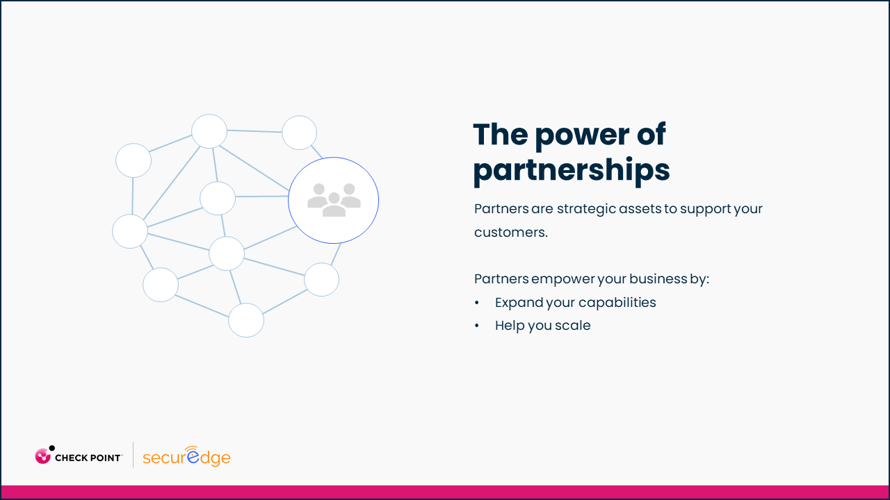
I wanna talk about this for a second. If you think about it at your house, when you order cable service from your local telco provider or cable company, the person that shows up in that van and installs the service, many times is not a badged Spectrum or AT&T company.
Certainly, today with the gig economy and the way that you've seen companies like Uber build these kinds of business models. We have to think about how can we “Uberize”, if you will, our service provider businesses, and then be able to utilize a model like that to expand and grow.
I think a lot of people maybe don't even think about that, or they see a big brand, like, a big telco, like, an AT&T or an IBM or whatever, and then when you actually work inside these companies, what you find out is that their service coverage and the way that they get this nationwide coverage is actually a network of partnerships. It's other companies that they're working with.
I wanna just reset the mindset of “partners are bad”, specifically around deployment and things like that. The partners can actually be a huge advantage.
Chad, do you wanna unpack any further than I did there?
No. I think that aligns very well with the way we view how you bring scale and predictability. We work in the channel. Partners is how we deliver our service.
It's getting the right tech at the right time with the right skill set. So, there needs to be transparency. There are a lot of different ways that these ecosystems are being set up today.
There are good reputations. There are bad reputations. The risk is that when you're working on your deployment, you're building your managed service offering, it's aligned with the partners that can act and behave with you and all these different types of events. We certainly see the capacity now for any size service provider to be able to win and scale larger deals because they have the agility and the subject matter expertise.
Our hope is that we can help bring some comfort to the idea of how to get people on-site. If I'm selling a particular solution, I have to roll it out to ten locations or a thousand locations in one state or all states or even globally you now have a mechanism to do that.
All the remote technologies that we're using, including the technology we're using for this event, have enabled that. I think that is the architecture that the operators of these MSPs when they start plugging in the right partnerships, I think there are opportunities for us to win deals that in the past, only belong to the largest of providers out there.
I think the opportunities are just spectacular in terms of that scale and scope. You have to be a subject matter expert and try to normalize getting it deployed or being able to scale, being able to finance. We have the mechanisms to do that. That's not gonna be the obstacle any longer.
What partners do you need to deliver NaaS?
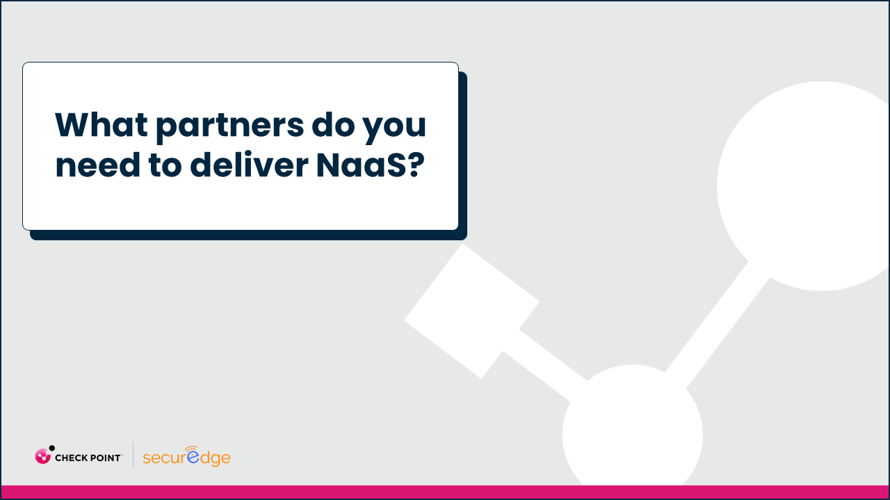
When we're talking specifically about Network as a Service, because that's obviously the topic of our webinar series, it really kinda changes how you have to look at the interaction that you have with the customer and so what we are talking about is when you're selling an as a service model, you're really selling a relationship that's long term.
So, If I'm just gonna ship somebody firewalls as an example, and even configure it for them, it's really transaction-based. It's a point in time, “Hey, I deployed this for you. You're good to go. Call me when you need me”.
When you start talking about delivering as a service model, now you're going in and you've got a sixty-month relationship. It really creates problems in the way you think about your business and so I wanted to talk a little bit about some of the challenges you might have.
The first challenge is maybe there's gaps in capability, and I'm gonna go deep into services and things like that, today because I think that's really important. The first problem I want is I just have a problem.
I'm missing something in my capability and, Joey, we were talking about this, earlier specifically about the smaller partners. Can you talk just a little bit about some of the challenges that the smaller MSPs are having in building, “as a service” models?
Great point. I think one of the things we're really seeing in the market now is tied directly to this is a talent shortage. Right? A key from the vendor's perspective to really help with this is to have technology that is scalable and easy to use for the service provider.
We'll get into exactly how we do that shortly, but things that we use like AI, intuitive management consoles, fantastic support resources, or things that the service provider needs. Because they don't have the resources of an enterprise company out there.
That's just for me when I see that every day, there's an abundance of need there where we talked about it a minute ago of really having that partner community. Check Point is a hundred percent partner-driven channel company.
It's absolutely key to offering an end-to-end solution. So, totally agree with this being a big challenge in the market.
From my perspective, being a service provider for fifteen years, we had this problem where there might be a gap in something that my team internally couldn't do, and I had to figure out where I was gonna go to fill this kind of service life cycle.
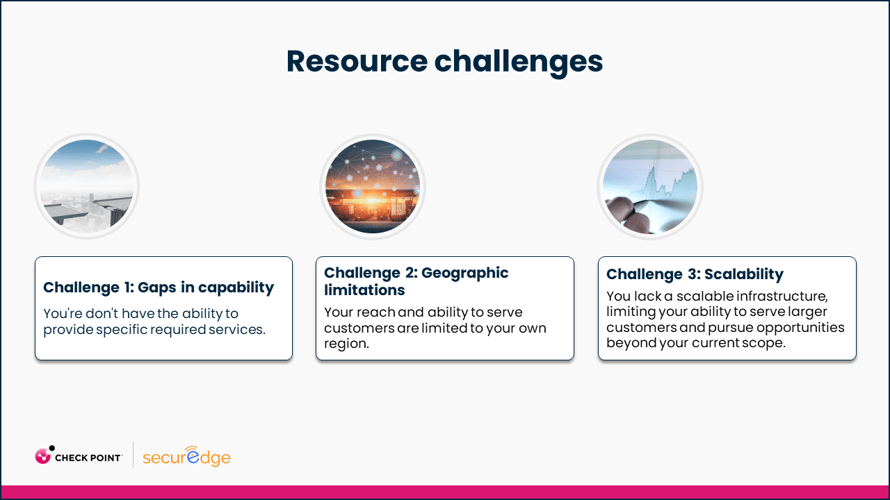
The other thing we see a lot is we are regional by nature so we're based in the Carolinas. We could cover the territory well. I had a few remote employees, but when we had to deploy in Portland, that was a big problem to put somebody on a plane.
So, we had the capabilities. We just really couldn't get there.
The third problem to solve on a regular basis was we really had the scalability problem.
So, hey, we've got a big retailer that's coming in, again, we're not a big company, but, we have several resources, but they want us to do three hundred site surveys in sixty days.
Alright. Well, how the hell are we gonna do that? We have a lot of these scalability problems.
So, when we're thinking about resource challenges, what I'd encourage everybody to do is just think about what your team looks like internally and then we're gonna map the services capabilities to what your skills are internally.
I'm getting ahead of myself a little bit. Those are the challenges.
Let me let's go through some of the partners that we think are critical and I'm also saying this because we started building a network as a service practice in twenty seventeen, and that was several years before we sold that company.
The partners that I'm gonna share with you are the ones that we had to implement as a company when we were building that kind of practice.
Financial Service Provider
The first one that we had to really tackle or figure out was how we're gonna finance all this stuff.
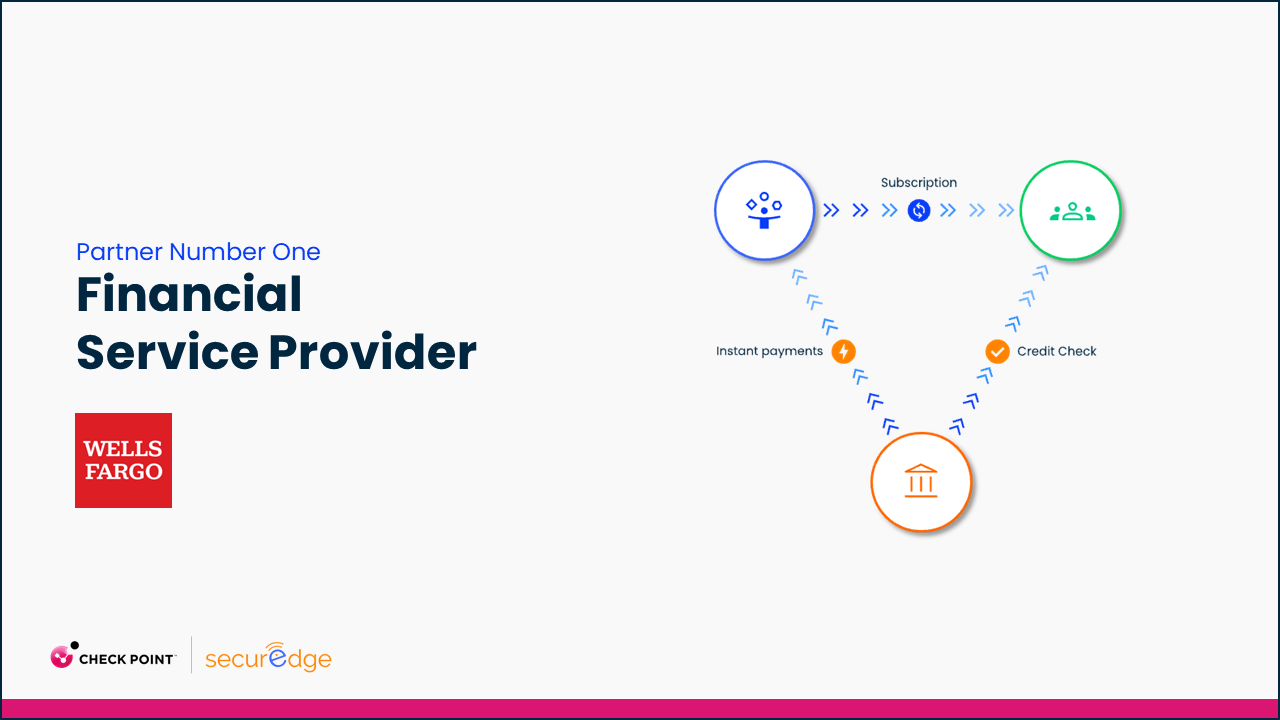
When you're talking about it as a service model, it's one thing to go in and say, hey, mister customer, here's a million dollars in equipment, and then you go buy it upfront, and then we're gonna manage it after you. That's really the traditional managed services model and you sell them stuff and that's good, but we want it to be even stickier.
We want the whole thing to be delivered “as a service”, which means we had to figure out how we take this financial services process and really embed it into how we're doing business as a company, which is really a different kind of workflow.
The first partner that I would say is very critical is a finance partner that has some sort of technology financing program that can fund essentially your “as a service” business.
I can tell you from experience if you design this correctly, it gives you the ability to scale with growing your upfront revenue, and still getting paid that one-time revenue, but then being able to grow the recurring revenue as well.
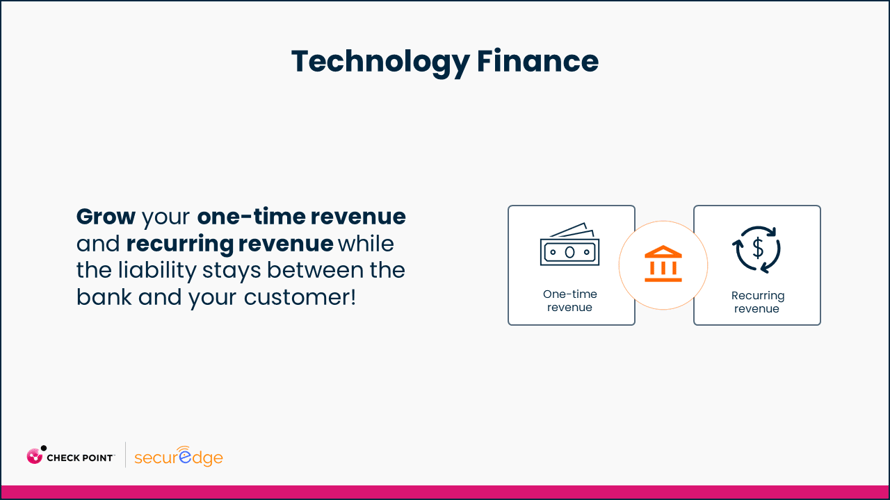
Obviously, that's the goal of every owner that's on the call today. How do I grow my recurring revenue and increase the value of my company?
I can't underscore enough how important financing or technology financing is and a company like Wells Fargo can provide those types of services.
The second partner is sitting here.
Manufacturer
You have to have a manufacturer and not just any manufacturer, I would say, but you have to have a manufacturer that wants to support you as you build an “as a service” model.
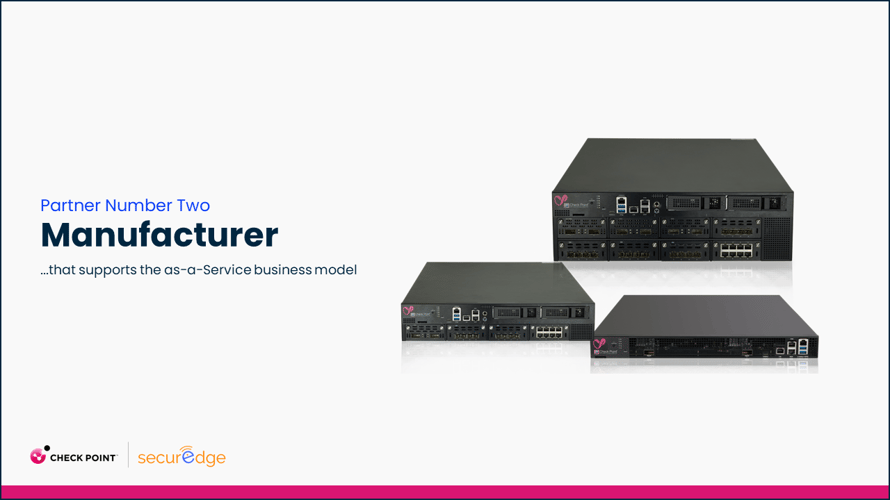
We're hosting here with Joey and Check Point. And so, Joey, I want you to unpack some of the Check Point programs that are really designed to support service providers once that equipment is installed.
Anybody can sell the firewall or the security services and turn it on. What are the tools that you guys have after that initial sale that you can talk about?
A hundred percent spot on there.
Just for those who may not have caught part one or haven't heard of Check Point, we started in 1993 in Tel Aviv, Israel. Today, we've got over a hundred thousand customers all across the globe. Really one of the larger pure-play security manufacturers in the world.
Phil's exactly right.
I mean, any company can sell products or services.
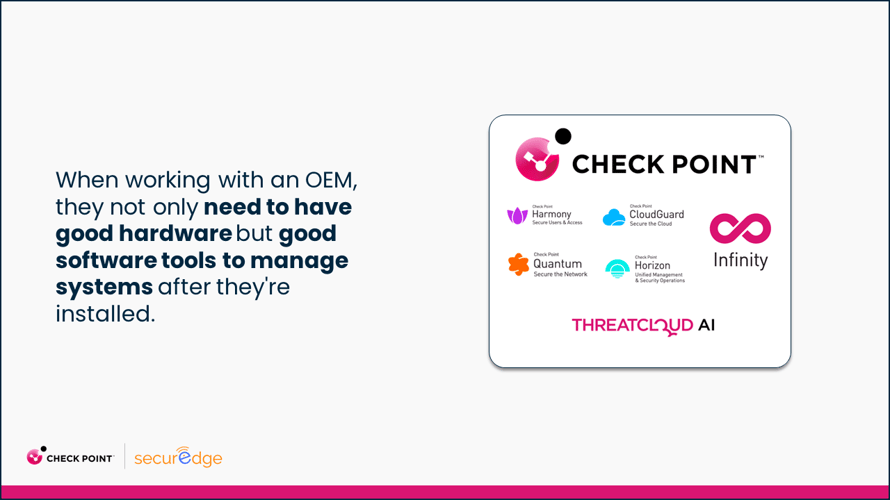
But at the end of the day, for the service provider and for really partner ecosystem to make sense. It's got to be easy to deploy, easy to manage, and easy to support. If you're gonna boil it down into three pillars because it's an ongoing continuation of a partnership.
When you think about that, really some of the areas to get started on continuously, that Check Point does a great job of our things like upgrades, onboarding, and integrations with third-party tools. That's where I've seen and a lot of my colleagues are seeing the rubber meets the road with the service providers.
One of the main areas Check Point does a great job of that is our infinity portal and this is gonna be the portal that our service providers are logging into to manage various technologies.
It's your single pane and glass cloud-based. You have the ability to have multi-tenancy. So, as a service provider with customers, you can be looking at deploying a mobile threat defense for “Client A”, and then two clicks later, you're gonna be looking at a separate client's email security dashboard.
That's something we're seeing a lot of success with and the market needs. We talked earlier about things that service providers need to scale and what makes sense coming from the manufacturer side. We're getting a ton of positive feedback with that.
Secondly, we talked a little bit about integrations and APIs. Check Point today has over three hundred technology integrations because not every service provider is the same.
I mean, Phil can tell you this. He's run one.
You're going to have service providers that have specialties in certain areas. Some have a telco background, a VoIP background, or a managed print background, and they're trying to get into the security space. Why we're here today is because they wanna offer services around it and they need resources from multiple channels, to help do that.
Another big area.
The onboarding and support are big because that's gonna be really key to scale.
Check Point does a fantastic job. If we wanna place the autonomy to do that on the partner, we've got self-setup wizards and resources that our partners are using on a daily basis. We've got partner community groups for any type of need.
If all of that wants to be done at the service provider level, we've got eight hundred numbers that are staffed by around-the-clock, experienced incident response resources that are just one phone call away. So, that’s another key component to it as well.
I wanted to prompt you on one other thing that I think is important. When you're thinking about, equipment when you're selling networking, there's clearly hardware and things like that involved.
In the old VAR business model, you would go into the customer and the customer would tell you how much money they had, basically. Then you would essentially figure out what equipment you could sell them.
If you were selling like latest thing in networking, you'd be like, “Let me tell you about all the fantastic features and the throughput on the firewall”. Their budget would dictate the best model they could have. No. I can't afford that. Okay. Well, this model will work as well.
I wanna point out, that it ends up being scenarios where you have school districts buying the most expensive device. That was a complete waste of money. That's what happens a lot in mercenaries.
In an “as a service model”, you kinda flip it to the service provider is now the, obviously, the managed service provider, the networking company providing that to their customer.
It actually changes the dynamic of the purchase because now I'm delivering a service-level agreement. I'm not delivering the most expensive firewall they can afford. I'm now delivering a service if you will.
What we've done, and what I appreciate, that we did with you guys, is We spent several months, like six or eight months or something.
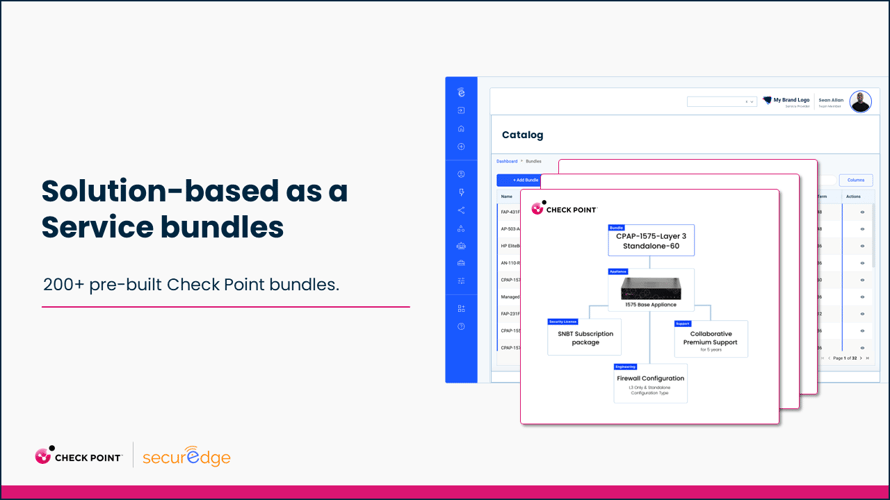
We took the Check Point product set and we designed bundles with it, and we said, this bundle is the right bundle when you're gonna deliver an SLA to a school district. This bundle is the right bundle for delivering the service into an office-type environment.
So, can you talk a little bit about that as well as the bundles?
Yeah. It's key because we talked earlier about every service provider not being that different. What they need to get a service model like this off the ground is something white glove and clip. Just very few clicks in order to get something stood up. You need those bundles that are tailored to large commercial customers or school districts or health care or things like state and local and school districts that fit the need or it's you have to spend time two to three months, workshopping what those SKUs are, how are the deliverables with a vendor resource beforehand.
But Phil and the teams here today have preset bundles that have already been configured that make sense for those environments. It's fantastic and it's really critical, to getting something like this off the ground.
Just a real quick comment on that. I really think this is the future of how IT services are going to scale by productizing everything that we do. There tend to be these customized transactions to pursuit costs are high, how you put all these things together.
In the end, you're starting to build these repeatable bundles and you start to see that trend. The SecurEdge platform really enables us to be able to build some of those elements and that's how we're gonna scale in the future.
I think about the past, how everything was customized, We're doing much of the same things over and over again, but the pressure for us to productize, I think is gonna be how we're gonna be successful in the future.
That initiative in using something that ties finance and all the different elements again to one. I want this. It's x dollars and the transaction is complete.
The Services Lifecycle
Let's talk about the service life cycle here for a minute.
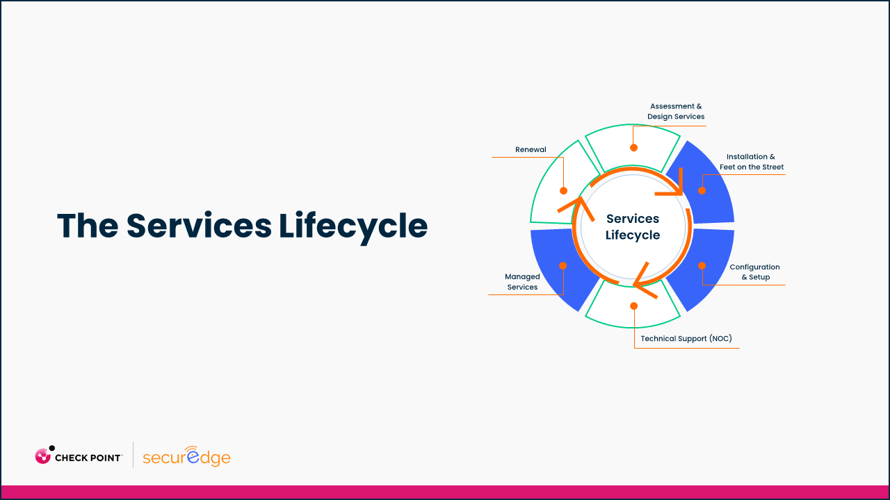
Like I said earlier, when you're selling an “as a service” model, you're really saying, hey, I'm gonna put this equipment on-site, but I'm actually gonna be responsible for it because I am the service provider.
Now that doesn't mean necessarily that it's all your team, and that's the power obviously of partnerships. So if you think about, let's say, the life cycle of eighty pieces of networking equipment, whether it's a firewall, switch, access point, whatever it is.
You've got this process that you go through where I've got to assess and design what the customer needs. Hopefully, that's in a pre-built package. Right?
I've got to install it and deliver it on-site. I've got to configure it and set it up either on-site or remotely. I now have to support that either with an NOC and/or SOC and provide managed services that are affiliated with that. Then I also have to renew it at the end of the term.
Now if you're looking at this in your traditional VAR, you're like, oh, this is a lot of crap that I don't have the capability to do today.
That's where we're gonna talk a little bit about partnerships. Now the first big opportunity I think when you're thinking about the services life cycle is how you put bodies in buildings to install and configure things.
Installation & FOS
We've got Chad, on the call today and so for the next few slides, Chad, I wanna start talking through some of these things. Talk a little bit about Kinettix and your business model, and feel free to go as long as needed.
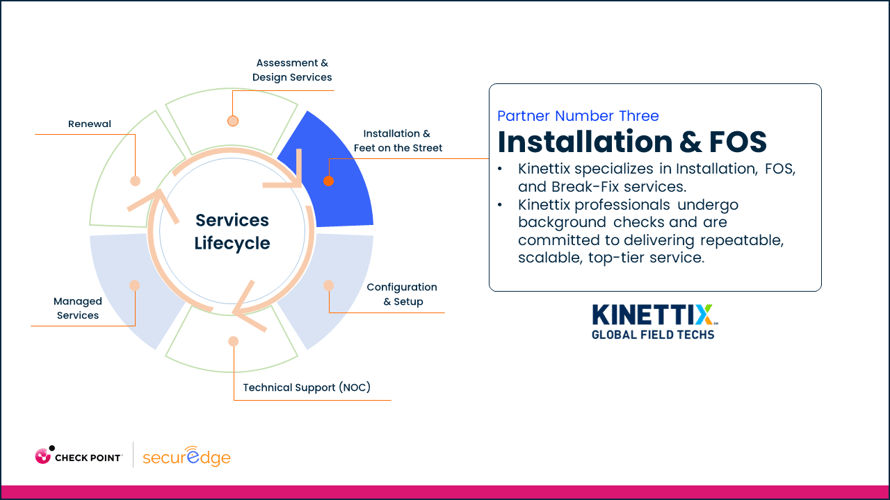
We have a few slides here on some of your product offerings, but go ahead and jump in and talk about what you guys do and how you help.
I wish I had taken the cue from you a little bit earlier about my background, but just to tie into how we do this today. I, like you, had a service provider. We were focused on the legal vertical and did a lot of the deployment on a regional basis or local basis.
We had our own W2 techs. We would install networks. This is a long time ago, so this, like, Novell and things like that. I started working with a company called Contingent and started working with this variable labor cost model. So, putting techs on-site and really viewed a lot of the stuff skeptical at the beginning of how do you get a person to go on-site to act as me to do quality work.
They have to arrive on time. They have to be able to communicate clearly. There have to be check-in and check-out methodologies and put all of these things together.
What I learned from Contingent, was how to really build and scale that model and almost this Darwinistic element where we'd identify the right techs and the right skill sets and having diversity sort of I needed to run cabling to enable the back office or the devices to techs that can configure things on-site, which has changed rapidly with the whole, we now work with service providers to provide all the engineering support, and we put smart hands on-site that basically, can take instruction and complete this.
So when we do this work today, we have a platform we call Dispatch One, which is integrating with your platform that we look at every tech, the background of what they've done, making sure they're compliant in the work that they do and have that scale and scope on a twenty-four by seven capability.
Over the last six years, we've developed a global workforce. So, we are truly twenty-four by seven. If it's after-hour work, we're doing cutovers and a lot of cutovers happen during weekends and after hours, etcetera.
We have an absolute scale to that.
Global Challenges
But for us, what's critical is to be able to to to assure that there are the right elements so that the service provider has a good outcome. Any kind of soft event like communication, they don't clean up the workspace, etcetera, creates end-user experience and escalations.
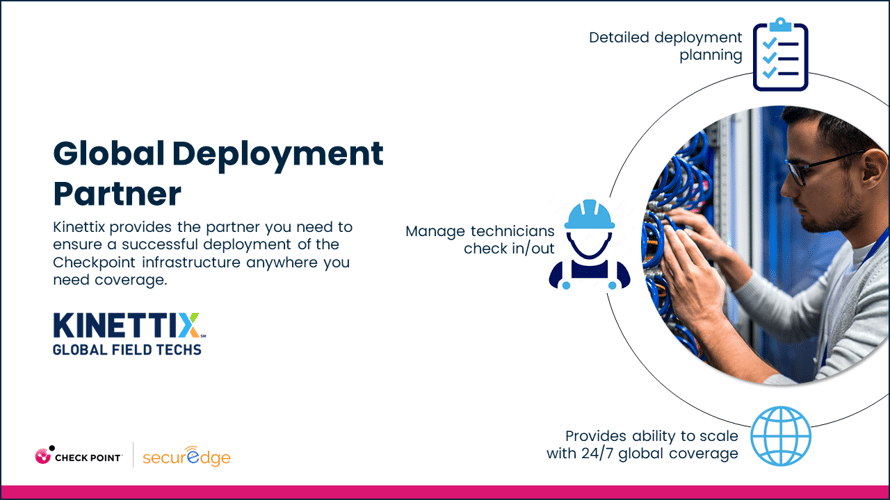
From a global perspective, what we've been able to do is provide an agreement in USD that gives you predictable pricing. Last year, we were in a hundred and eight different countries where we've been on-site completing work for a variety of small to large providers When you think about things globally, because a lot of your customers will have manufacturing plants or different types of facilities. They're expanding globally.
That shouldn't prevent you from being able to expand the scope of what you support for them. We're looking at the currency risk. We're making sure that everything we provide, we manage that, any of the tax implications, all when we provide a transaction, it's inclusive.
There's no withholding tax. There are no VAT taxes that we're collecting later. We have known techs. So, we're putting techs on-site in different countries.
They have experience with us to complete that. We have full support across the time zones and of course, it's being able to communicate with the people that can check in and check out to make sure that everything meets what the insight was looking for as well as to check out with the group there.
So, my job is writing software or creating software, and your job sounds way more difficult.
Well, sometimes. It depends. It's human beings, and so that's why with every tech that we work with, we match them with another person to make sure things are there. You're so good at your lead-ins there, Phil.
Optimal Results
So, for us to create an optimal result, the first thing we have to have good definitions.
When a tech is going on-site, sometimes we have failures because we're not giving them good instructions. It appears to be a bad tech, but if you're told to go on-site and not given much information that can treat the wrong outcomes. We spend a lot of time in talent development, so making sure the right skill sets.
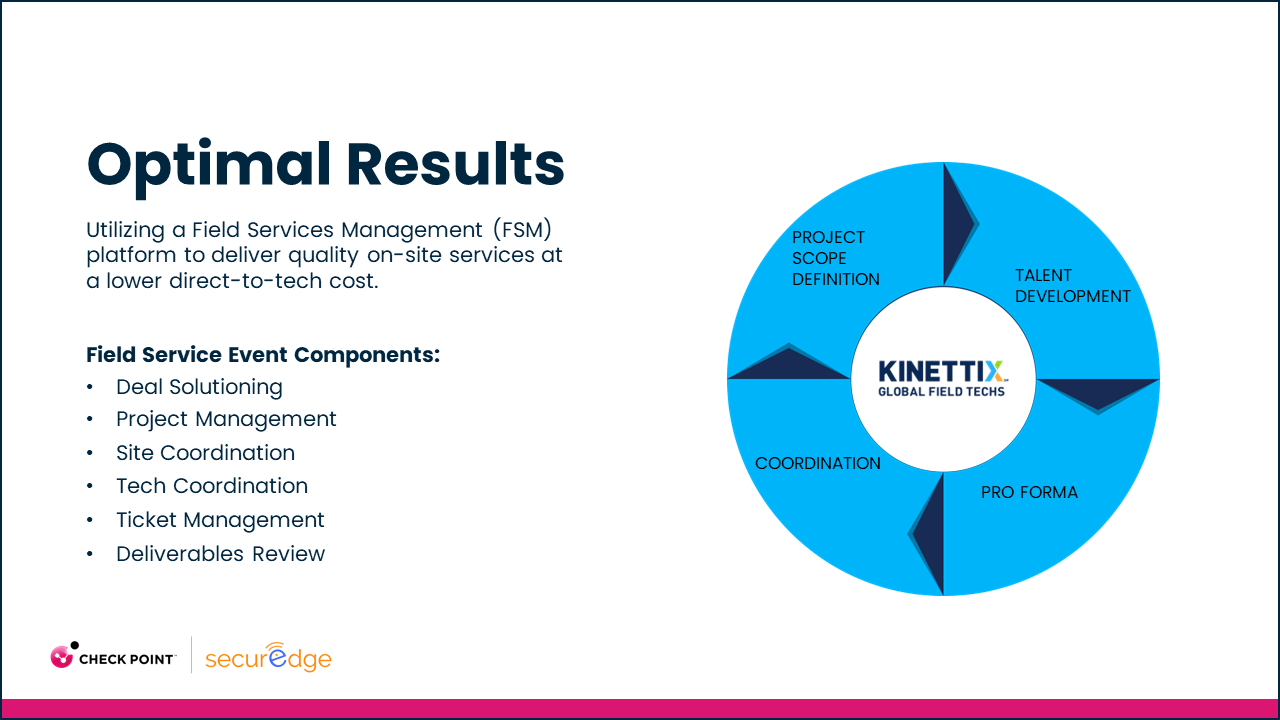
I think an exciting area of our space where because of the remote technologies that exist, we can have reliable, predictable people, but your teams can also augment. You don't need a Check Point, certified tech to be on-site to configure a device. We have to make sure we have accessibility to that device and then we can help resolve and remediate and get the tech off-site.
It's also building the right performance and budgets to your earlier point. There's a variety of different labor costs that's out there in the United States. We have a lot of challenges with co-employment. If you put techs on-site in certain states, you have to make sure you're compliant in a lot of different ways.
So, having the budget to put that together makes all the difference and then, of course, if it's coordinated correctly, we think all these things need to get together to create a quality outcome.
When we were a VAR or service provider, we were using services like Kinettix as well. We would get into a situation where we might have three hundred locations we have to cover and I could look at my team and go, I think we can get to fifty locations in the time frame we need it and then we would go and try to find you to outsource and to partner with.
I think the key there on your chart here is, it's the coordination. To the customer, it really needs to feel like one service provider. That's the company that they're working with and then your service needs to feel like it's integrated directly in.
What I like about what you've done with your platform, if I could give you some props here, is you focused on the software and the API framework so that could feel seamless. If you think about this from a customer's perspective, our customers are ordering pizza and they know the real-time status of their pizza. If they can do that, they should be able to order millions of dollars in network infrastructure and services and know exactly the status of what's happening at their sites in any given time.
Let's talk a little bit about some of the deployments you've done because I want people to think about it in the context of, “How can I use this? How can I do this at my company?”
Some of the companies on the call here today are actually telcos. Some of the companies are MSPs and VARs. So, run off a handful of stories on how people are using your service.
Yeah, just for a point of clarification, Starbucks is what we would call an in-client.
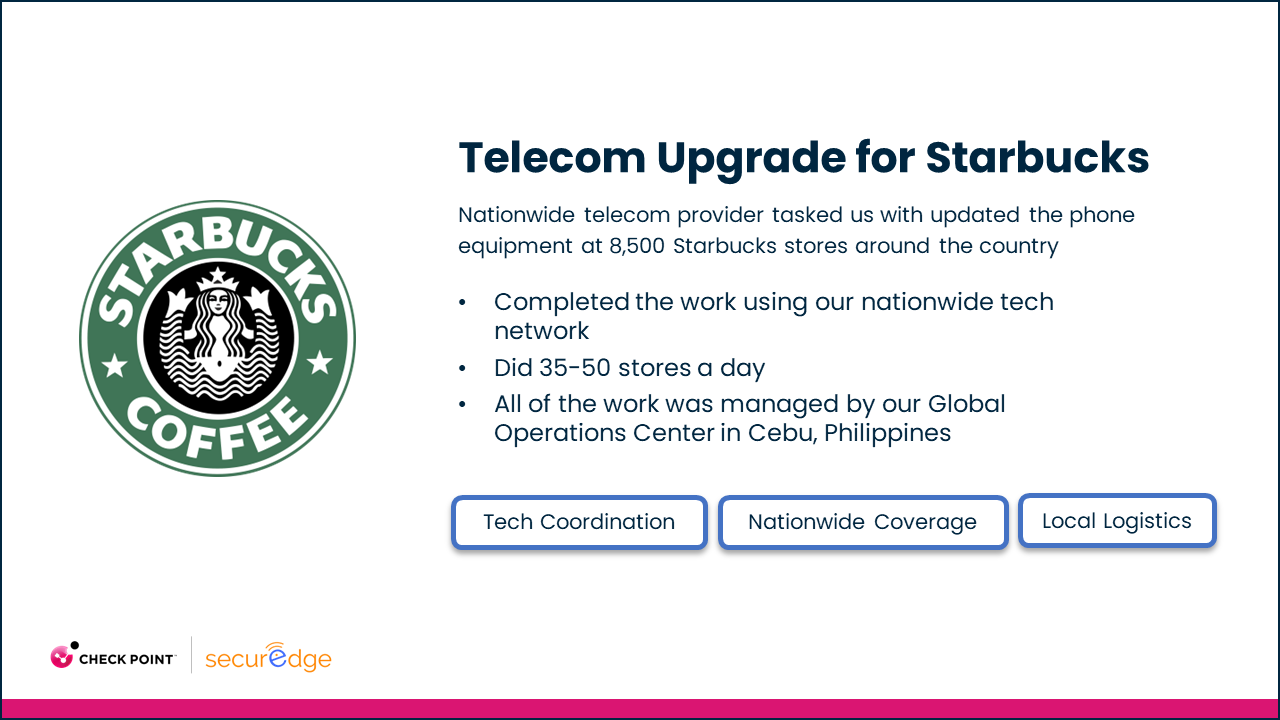
We are channel-focused on what we do. So, we would go on-site. There was a rollout. There was an ATA. There's a network infrastructure update, eighty-five hundred locations. We had to do that in a pretty compressed period of time.
We're doing thirty-five to fifty stores per day. So, we're working at tech coordination, local logistics, getting the right edge devices on-site, and then we even augment that team because when you're doing a rollout of thirty-five to fifty locations, we typically are released from that site by the carrier, MSP, or the telco. We go on-site, we do the swap out, we do the cabling, we're going through these scripts, and then we're checking in, and everyone's saying, yes, everything that we expect is occurring and the tech is released.
Depending on how schedules are set up, this is where you have to stagger things so we don't overwhelm the service center, the help desk, or the NOC that is taking on that event. We have also leveraged our Saboo Center in the Philippines with technical coordinators that on an as-needed basis, help augment that check-in/checkout.
I'm calling that out because not only is it us adding techs on-site to get a scale for the reach, but you also have to plan for doing a rollout that has the compression. You need the ability to release that tech and that means your staff has to be available to receive the call and go through the test-out methodologies, and we can help augment that. That's just an example of what we did with the carrier and that just shows breadth to it.
JoAnn's Fabrics is another one that was a total back-office refresh. This gets a little bit more complex. We're refreshing the network infrastructure. There are cable clean-up events that occur. A lot of times you go into these locations, you're changing out that infrastructure. There's a lot of opportunity to look at. What the battery statuses are.
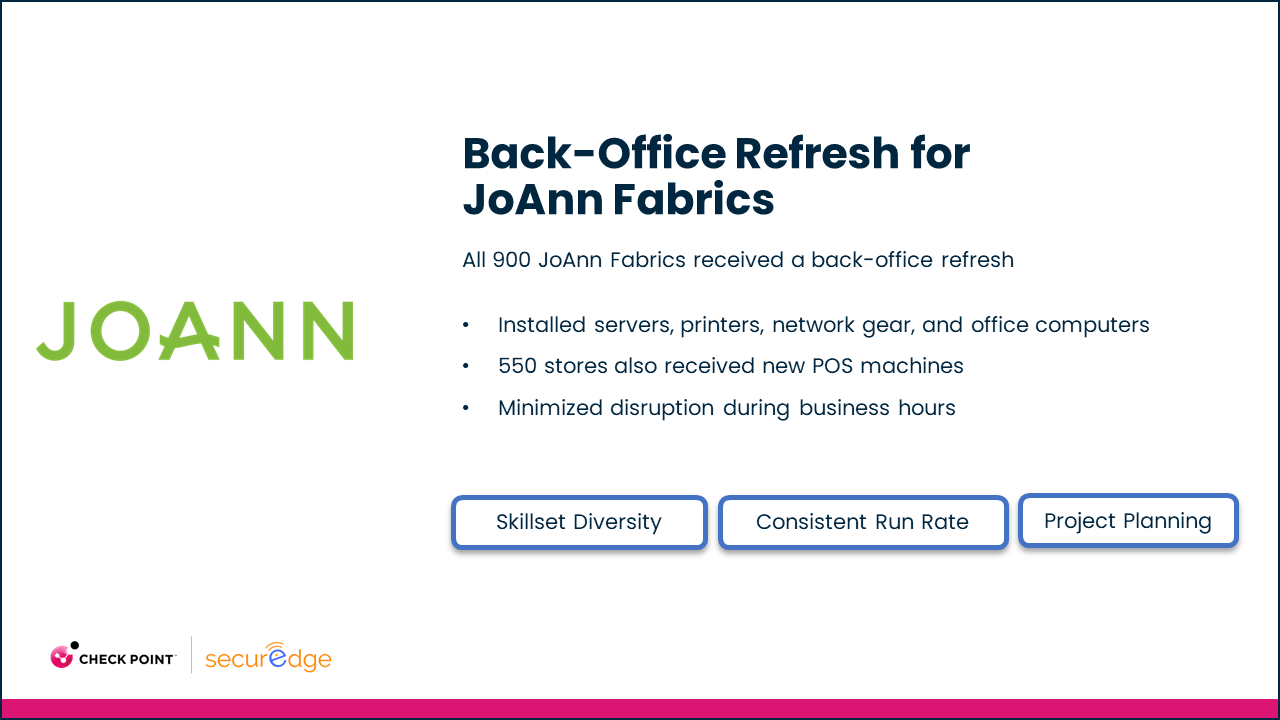
We've seen situations where there's old equipment. The cable needs to be cleaned up or re-pulled. It's multi-site, so it's multiple days staggered over a period of time.
A lot of the stuff in these cutovers happens after hours. Very limited windows of time when the tech can come on-site. The store gets shut down. It has to be reactivated.
There are milestones that you're looking at. If we're gonna migrate a particular element of that network that all parties agree that we can meet that so the store can reopen. That's looking at a lot of different skill set diversity because structured cabling might be different than some of the network infrastructure that needs to be set up there.
Then we're coordinated tightly with this service provider to make sure all those events because not only is it the MSP that is telling us the tech is ready but the end customer also says, yes, my store is back into operation, and devices that we're looking for. There are only these bridged events that are out there.
A question here is how many case studies are bragging and how many are appropriate? You put three in here, so the rest of the webinar is gonna be case studies from Chad.
Yeah. Sorry. This is my last one.
I'm just kidding.
This one has to deal with more specialized teams. Sometimes, if it's a more regional area, you have teams that can roll over from site to site, and, again, coordinate that with the groups and put those things together.
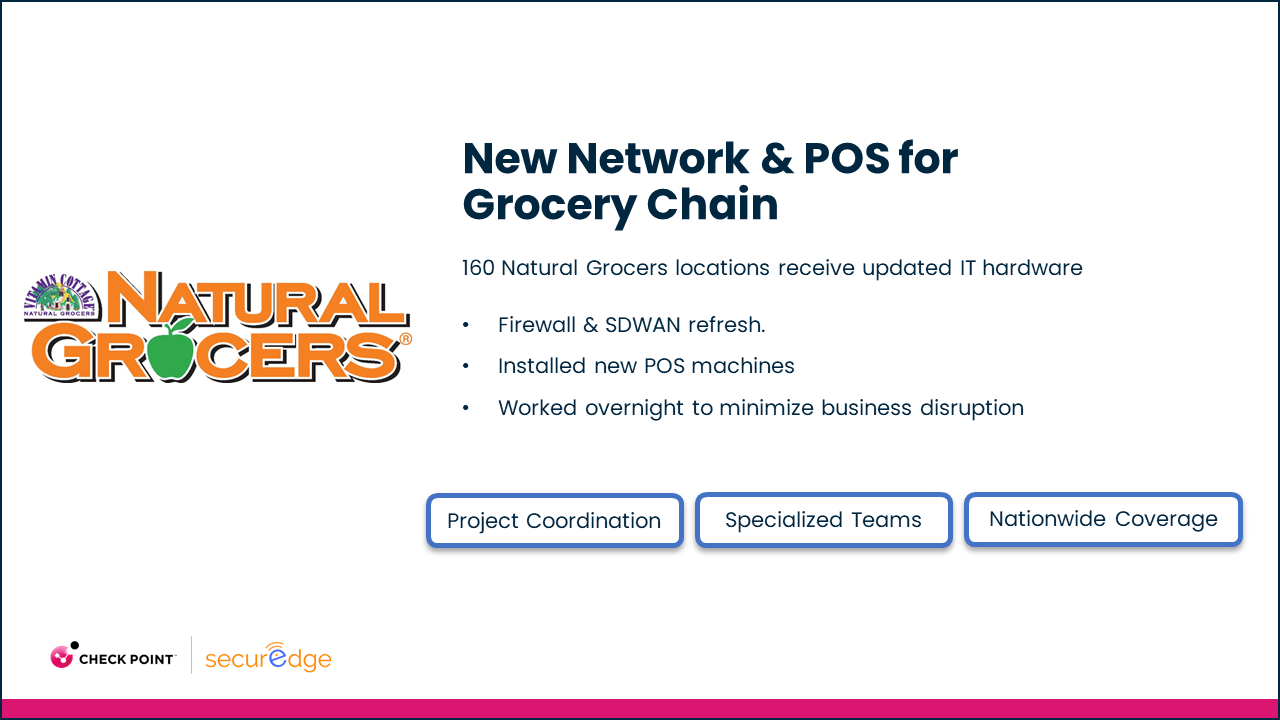
This really comes from years of success and failure. Going back to the original slide, having the right budget, having the right expectations, and the right installation scripts. It is a fully integrated event. So, even though we wanna position ourselves as being subject matter experts in field services. It's a commodity. It's a utility. It’s out there.
We have constant pressure to drive down our costs, but it's a fully integrated solution and it has to be nuanced when the tech goes on-site, and the teams are doing these rollouts, all these different elements have to be coordinated.
That's where the service provider becomes that architect, bringing in these different providers. When we go on-site, we appear as a service provider. So again, these are in-clients for us. They may or may not know who we are and that's by design.
In order to get a tech to leave a site successfully, requires all parties to be synchronized in that event.
I love it. So, the other thing is, when I had a service provider business, the installation feet on the street was one of those things that was really hard to predict.
You might have a rollout for a customer and you might have hundreds of locations and then three months from now, you're not doing anything like that. It was really hard for us to hire internal staff, not to mention, manage the check-in and check-out and make sure that those technicians were behaving properly when they showed up on-site. Maybe they had smoked marijuana before they showed up and maybe they hit on the people that work there. There are all sorts of stories we had.
It's just a great opportunity to outsource that to somebody like you since that's what you deal with. I think that your job is also very hard but also very necessary.
I think even the largest serve service providers, I spent several years at CompuCom, which is a very formidable IT service provider out there. Three thousand plus W2 staff, but when it came to rollouts, very much using this contingent labor pool that that is out there.
There are a lot of different talent pools that exist. This is the great thing about platforms.
Finding techs, I think, is becoming a little bit easier, but the key is to tie together all those different elements and coordination. The key question is the currency of the tech that's going on-site, so using service providers like us might have a tech that we are spending multiple transactions with. We know who they are and that can mitigate some of that risk because bad things do occur, and this is Darwinistic.
If techs behave poorly, we can remove them from the site and we will never use them again. We do find that many times the core issue of that failure is not always the tech. There are a lot of different events that occur where we didn't do a good job of preparing them to go on-site.
That's where I think these platforms become more pervasive. When a tech arrives, we need to have well-written instructions and be very precise about what's happening out there. So, we feel like it's still a human-to-human interaction that has to occur.
We believe in the future of AI and all the things that are occurring but when you want a person to arrive on-site and have that interaction with the site contacts, those are the things that drive the strongest of experience. I think the key question to ask the providers is, how current are you in this particular area or country or city that you might ask them to do work for you in?
NOC/SOC
Let's move on. So after you get the equipment installed and set it up, the other big opportunity that we find is that when you're selling as a service, it's important to be able to support the customer after the network is installed. Now you run into a problem do I build my own network operation center? Do I build my own security operation center?
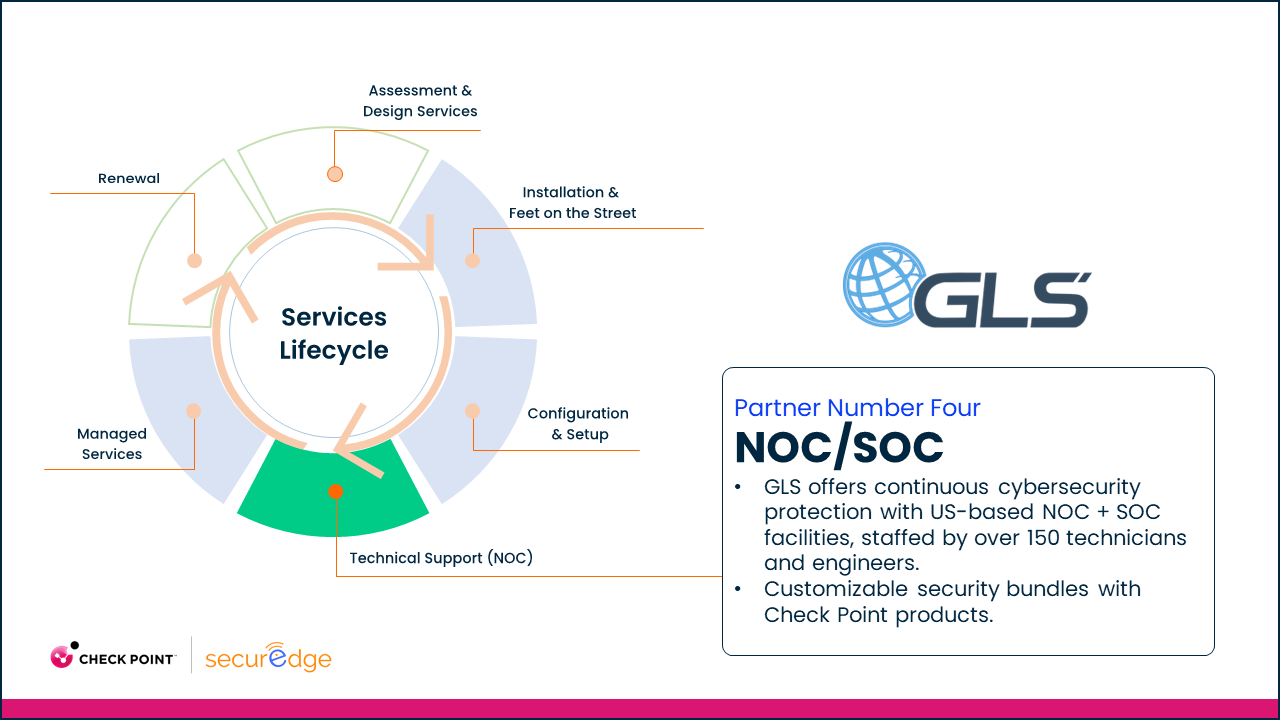
The problem with that is obvious. It's really expensive to do that. When you're getting started in the network as a service business, you would wanna consider outsourcing that because there are a lot of great companies out there.
An example that we're using here is Global Linking Solutions, which is probably a company that almost no one has heard of but you've probably done business with a company that is using Global Linking Solutions to deliver essentially a managed NOC and SOC service. I think this is a great opportunity where if you're getting started in the business, you're using an outsourced partner until maybe there's a point, and I say that maybe, there's a point where you do build one internally. What you'll find is that even when you go into the big service providers or even the telcos, a lot of those companies are outsourcing to companies like Global Linking Solutions.
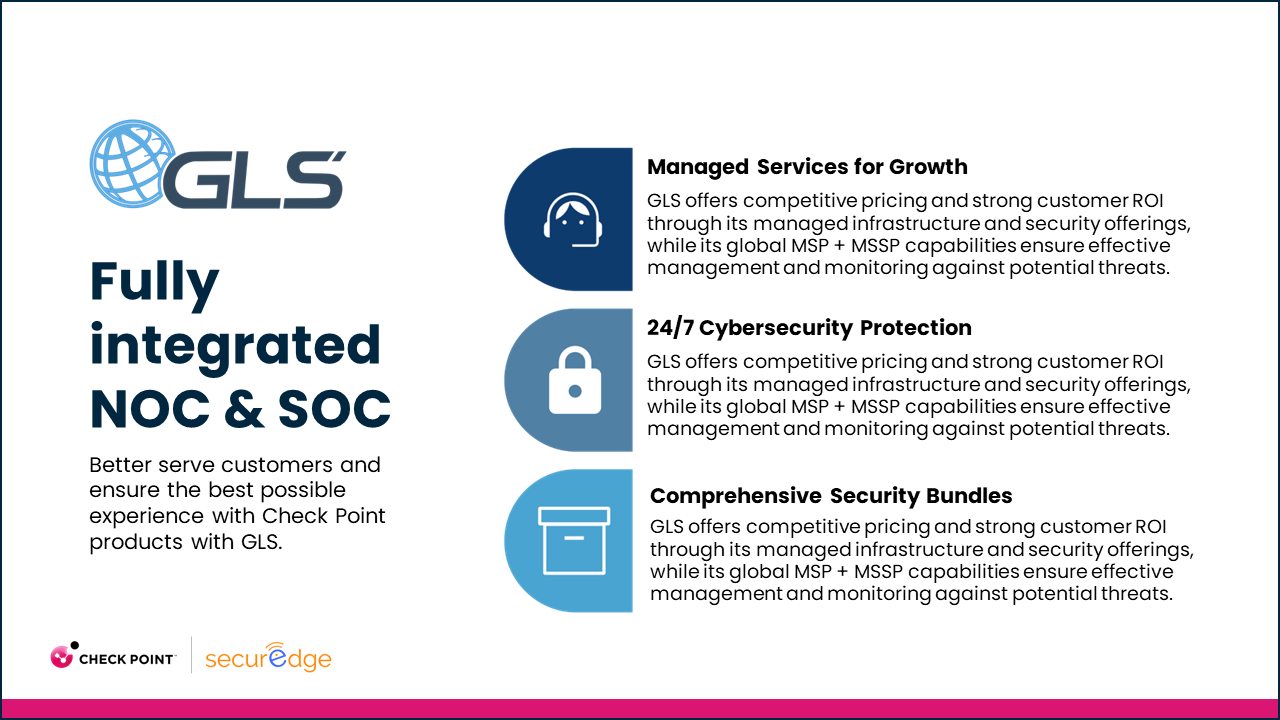
The opportunity here is you're essentially paying per seat or you're paying per device or you're paying on a per device basis for a service and they are delivering twenty-four by seven call center support, NOC services as well. Sometimes you can actually get it packaged together and that's our experience with a company like GLS.
Maybe they have an offering where you can include the management of the Check Point security services along with an agent-based call center. It really takes the cost structure out of being able to deliver that “as a service” offering.
We actually thought about having GLS on the call today, but it was just too many people. We'll do another session and I'll get the CEO of GLS on here because they're a fantastic partner that I think everyone should consider.
Central Office
How do we tie partners together for Network as a Service? The last problem that we have time to cover today is, how you tie all this stuff together. You've got Chad with Kinettix delivering technical services. You've got GLS delivering the NOC. You've got Joey with Check Point delivering the network infrastructure.
Your own team, if you're a service provider, is probably doing engineering services and things like that. The problem becomes, how do I deliver a unified experience to my customers so they're having the same type of experience they would expect on AWS Amazon, or other kinds of modern platforms?
What is Central Office?
What we created, and this is why we're here today, is when I was a service provider, we had a lot of these internal problems.
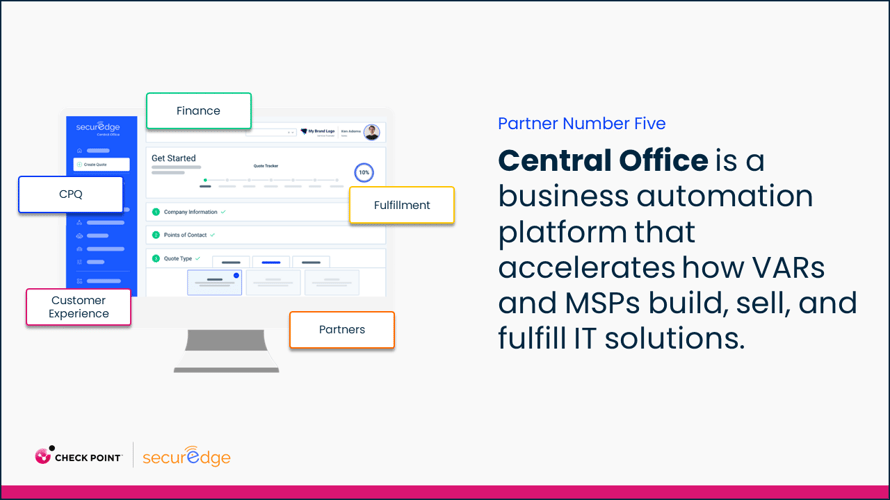
We ended up building software that we call Central Office. We define or describe it as a business automation platform that really just ties all these things together.
The problem with a lot of IT companies today is actually a lack of connectivity internally, which is a funny topic to be talking about.
We built a framework to tie partners and apps together inside essentially one platform and the advantage here in thinking about what we talked about today with NOC, Kinettix, Check Point, and all these different companies is we can merge all those things together essentially into one platform.
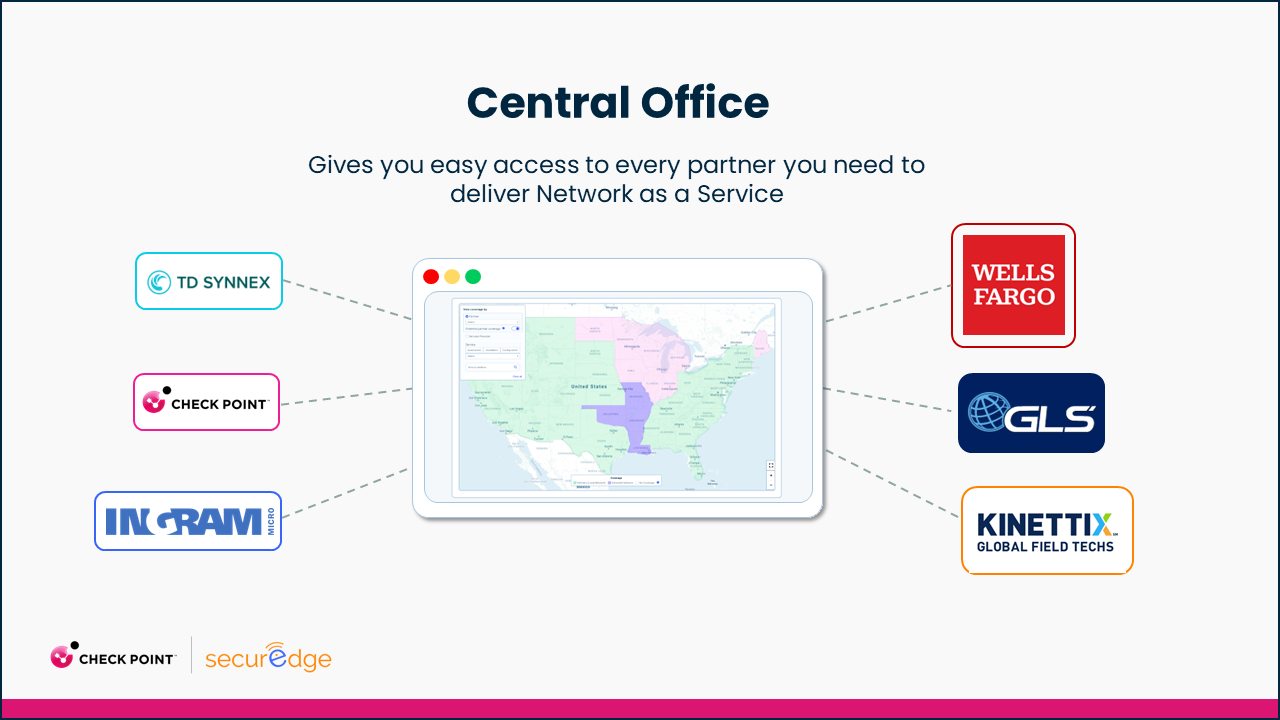
That just makes it easier to do business because we built workflows that automate a lot of these functions. If you think about it, if I want to give my customers a digital experience, well, the only way to do that is to build a digital infrastructure internally that I can put APIs in front of that, so that my customers can receive that experience.
If you think about tracking pizzas, well, what's happening inside the restaurant is somebody's checking it in at every station as that pizza is being made, and that's what's giving you those real-time updates. So, what we did with Central Office is, we took that modern idea and we built those types of workflows.
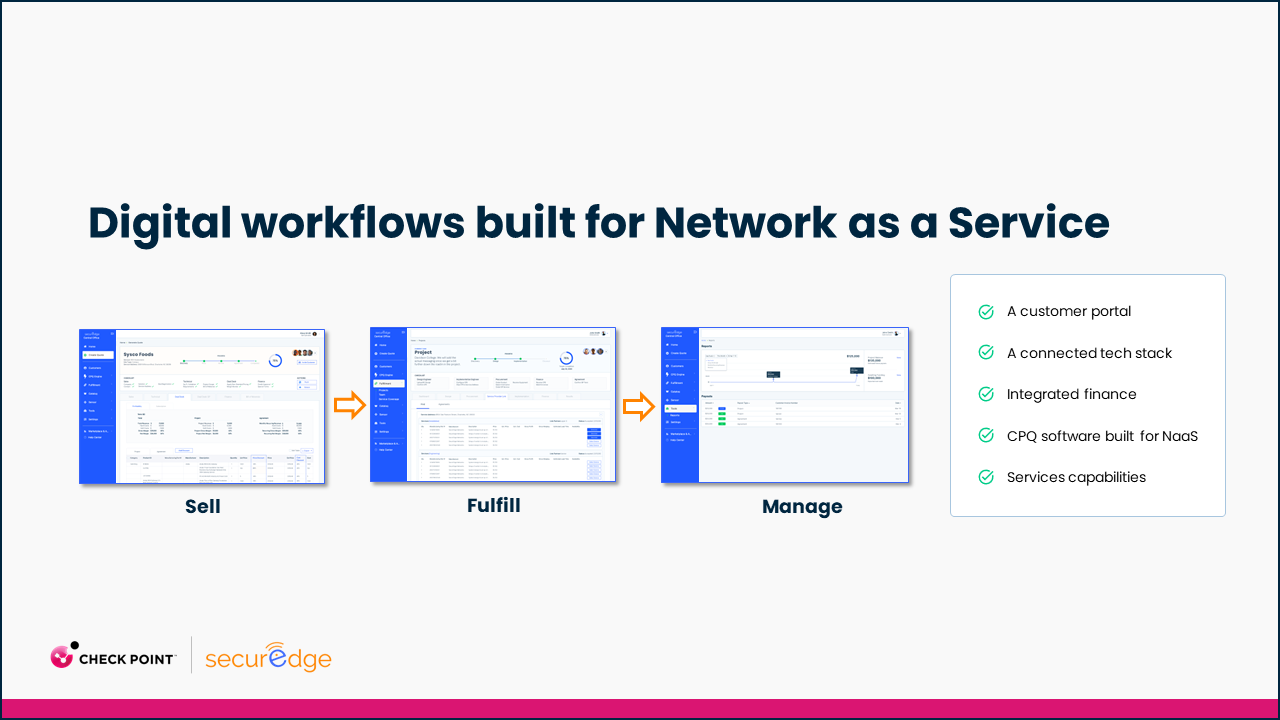
How do you sell? How do you fulfill? How do you manage customers in a digital framework? Not that we're replacing a lot of existing tools but really connecting together existing CRMs, existing ITSMs, and existing PSA software, and then we're just tying in partners to help you fulfill those types of things on demand. So, that's where we are the fifth partner that I believe is important.
Questions
We do have some time for questions.
Let's tackle some questions, give a couple of calls to action, and then we'll wrap up.
So first question I have here is for Kinettix.
What's the lead time you need to deploy a technician?
When we have an activated account or an agreement, we have rates that are based on skillsets and criticality. We have techs on-site in four hours, eight hours, next business day, etcetera. If it's more of a planned project rollout, we can work with the teams. That process usually takes about five business days to activate, but we have an on-demand service that could be as quick as four hours, assuming we're integrated and onboarded, but that's our response time threshold.
How do you price your services? Is it a fixed fee or hourly?
That's a very good question. That's changing over time, but right now we have rates that are based on skill set and criticality. So, if we have two days or more and it's a standard tech, that would be a lower cost than an advanced fiber tech that you need on-site in four hours. It would be consumed as needed.
That is a little bit different even though I agree with Phil completely. We want a monthly recurring model, but people will consume the service as needed. We know and believe that anything you remotely remediate avoids that truck roll or the tech on-site would be the first pursuit. It's consumed as the tech is on-site.
The next question is,
Can the Check Point bundles within Central Office be edited?
If a partner isn't looking to use one of our preconfigured bundles that we talked about, we've absolutely got the ability to manipulate and build whatever configured bundles we'd like. That's a testament to Phil and his team's work and what they've done with our catalog. From my side, absolutely.
Yeah. I'll pile on that. So, if you think about how bundles are created today, somebody like Check Point will create their own bundle and that might be a device and the licensing and the services that go along with that from their perspective, their price, their security services, primarily.
If you're a VAR or MSP, you're adding your own services. It's really important that when you're thinking about bundles. It's really your bundle for your customer, and your bundle is gonna have your configuration services. It might have an installation service from Kinettix inside your bundle. There's all those types of things you have to think about.
The key understanding is that it's the service providers bundle and not just the manufacturers bundle. So, yes, you can you can package however you want.
I think just to add to that real quick when I was describing our break-fix or on-demand service, what we've done with SecurEdge is we've taken a lot of these different types of activities, different infrastructure types, and that would be a fixed price. Built into that bundle, we know generally the level of effort will have consistent scope and assumptions. We make that predictable, which aligns with what you just described. In those models, the price would be embedded in the bundle, which again is where I think this productization future is going.
That's the way to consume it. That way it's predictable. The tech understands what they have to do, and we've done fixed predictable pricing for years and believe this is the right path.
We probably have time for one or two more questions.
The first one is for Kinettix again,
What's your vetting process? How do you guys vet tech?
We go through a variety of onboarding methodologies.
We will have obligations to do background checks and skill set assessments.
We'll integrate with a couple of different talent pools that are out there. We're looking for frequency of usage. So, we wanna understand if people show up on time. We get quality feedback from our customers and that's all tracked. We have an ongoing vetting process and that's constantly shaping.
There are things around skill sets and background checks. There's co-employment and identification risk and things like that. We have to make sure we're being compliant and so there's a lot there in terms of how we put people on-site.
We have a badging process as well. There are skill sets and certifications that are credentialed. Check Point may say this person has this certification and there are others that just have the experience. We see this very much in the Cisco world maybe you don't have to be a CC&A, but if we know this tech has done a lot of Cisco infrastructure work. That helps indicate a kind of score and then as tickets are being filled, the system will bring forward the most qualified candidates to put on-site for that particular task.
Next Steps
That’s good. I think that's all we have time for today. We'll have to follow up with them by email and answer their questions.
We have a couple of calls to action. If you're interested in learning more about the Check Point program.
It's checkpoint.com dash partners dash MSSP program. If you're interested in connecting, with Check Point and learning more about, the Check Point program.
If you're interested in learning more about Kinettix and Chad's company then you can see the link here on the bottom as well.
This gonna go out after the call where they'll have these links as well as access to the replay and some other handouts.
Alright. Perfect. That's great.
Information on our platform, which is a Central Office, you can find out more about it on our website.
Now we have one more webinar in this series.
The last one that we're doing is actually the one that probably everybody wants to talk about which is all about automation. So, there's a lot of talk about generative technology and what you can do with it and we're gonna talk about it. I think a lot of people talk about Chat GPT and all these cool tools, but then we're in the IT industry and the question is, well, how do we use everything that I'm seeing around me? How do we use that internally?
We're gonna talk a little bit about the opportunities and actually demo. So, in the last session, we're actually gonna demo some functionality inside of our software where we're using a generative technology and talking specifically about how to use it in a network as a service business.
So, a fun one if there is such a thing as webinars being fun but that would be a good one.
With that, Chad and Joey, thank you so much. I really enjoyed, hanging out, and talking to you guys today.
Yeah. Likewise.
Thank you, Phil.
It was great.
Thanks, Phil.
Talk to you soon.
END OF WEBINAR
---

